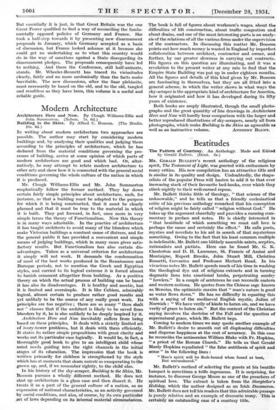Modern Architecture IN writing about modern architecture two approaches are
possible. The author may start by considering modern buildings and, by analysing their qualities and judging them according to the principles of architecture, which he has deduced from the material conditions governing the pro- cesses of building, arrive at some opinion of which parts of modern architecture are good and which bad. Or, alter- natively, he may attempt to relate modern architecture to other arts and show how it is connected with the general social conditions governing the whole culture of the nation in which it is produced.
Mr. Clough Williams-Ellis and Mr. John Summerton emphatically follow the former method. They lay down certain fairly simple principles about architecture, such, for instance, as that a building must be adapted to the purpose for which it is being constructed, that it must be clearly planned and that it must be true to the material in which it is built. They put forward, in fact, once more in very simple terms the theory of Functionalism. Now this theory
is in many ways admirable. In the practice of architecture it has taught architects to avoid many of the blunders which make Victorian buildings a constant cause of distress, and for
the general public it has provided a convenient and simple means of judging buildings, which in many cases gives satis- factory results. But Functionalism has also certain dis- advantages. Taken as a universal criterion for architecture it simply will not work. It demands the condemnation of most of the best works produced in the Renaissance and Baroque periods, not to mention the Greek and Egyptian styles, and carried to its logical extreme it is forced almost to banish ornament altogether from building. As a positive theory on which the actual process of building can be based it has also its disadvantages. It is healthy and ascetic, but it is limited and oversimple. It is like Cubism, admirably logical, almost certain to produce rather good results and yet unlikely to be the source of any really great work. Its principles are too negative ; there are so many " thou shalt not " clauses that if the architect is likely to be saved from blunders by it, he is also unlikely to be deeply inspired by it. Architecture Here and Now inevitably suffers from being based on these principles. It deals with a strictly limited set of ivory-tower problems, but it deals with them efficiently. It states its rather simple propositions with great clarity and works out its particular case logically. It would be, in fact, a thoroughly good book to give to an intelligent child whose mind needs guiding into the right channels in the initial
stages of its education. The impression that the book is written primarily for children is strengthened by the style which has at moments that sham naivete so exasperating to the grown up, and, if we remember rightly, to the child also.
In his history of the sky-seraper, Building to the Skies, Mr. Bossom pursues a wholly different method. He does not
shut up architecture in a glass case and then dissect it. He treats it as a part of the general culture of a nation, as an expression of national characteristics, as an activity governed by social conditions, and also, of course, by its own particular Jet of laws depending on its internal material circumstances. The book is full of figures about workmen's wages, about the difficulties of lift construction, about traffic congestion and about drains, and one of the most interesting parts is an analy- sis of the relations of all the various firms under the supervision of the contractors. In discussing this matter Mr. Bossom points out how much money is wasted in England by imperfect collaboration between architect, contractor and owner, and further, by our greater slowness in carrying out contracts. His figures on this question are illuminating, and it was a revelation to the present writer at any rate to find that the Empire State Building was put up in under eighteen months. All the figures and details of this kind given by Mr. Bossom are fascinating in themselves, but they are all fitted into a general scheme, in which the writer shows in what ways the sky-scraper is the appropriate kind of architecture for America, how it originated and how it has developed during its fifty years of existence.
Both books are amply illustrated, though the small photo- graphs and the great quantity of line drawings in Architecture Here and Now will hardly bear comparison with the larger and better reproduced illustrations of sky-scrapers, nearly all from photographs, which make Building to the Skies an agreeable as well as an instructive volume. Arrrnoxv BLUNT.


































 Previous page
Previous page